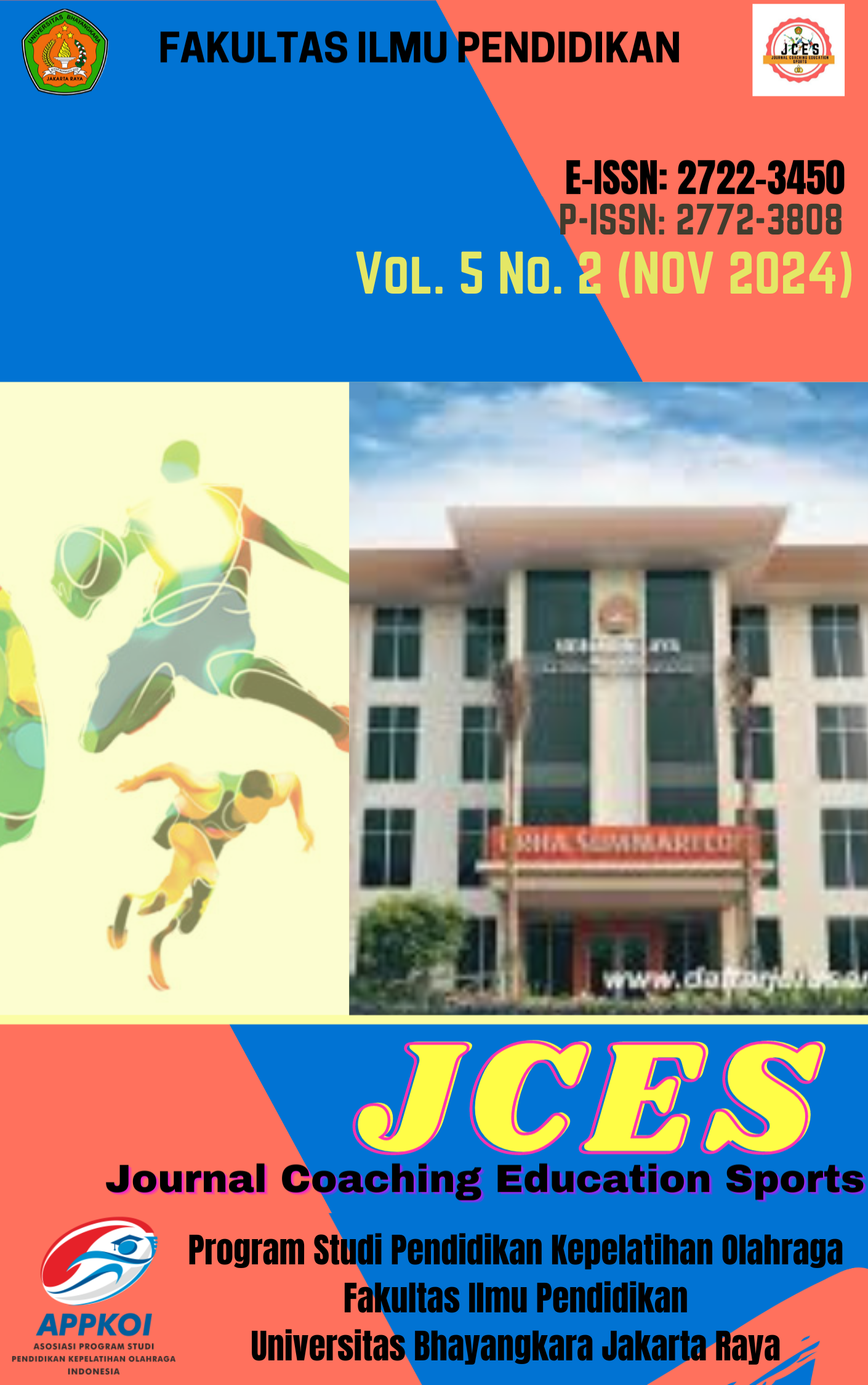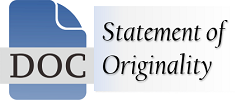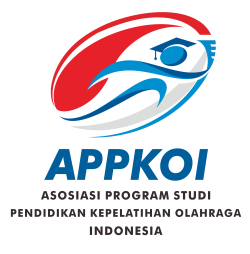Physical Fitness Survey of Members of the Communication and Electronics Service of the Indonesian Navy Headquarters
DOI:
https://doi.org/10.31599/yek40889Keywords:
Eletronika Headquarters TNI, Physical Fitness, NavyAbstract
This survey aims to measure the level of physical fitness of members of the Communication and Electronics Service at the Navy Headquarters. Data was obtained through a series of physical fitness tests which included the 12-minute Run Test, Pull up, Sit up, Push up and Shuttle run. The survey results are expected to provide an accurate picture of the physical condition of personnel and become the basis for developing a more effective physical development program. This research is a descriptive study with survey and measurement test methods. The subjects of this research data are members of the Communication and Electronics Service of the Navy Headquarters, age category 29 to 40 years as many as 30 respondents. Data analysis techniques using fiber percentages calculate the maximum and minimum values and standard deviations. The results showed that most of the physical fitness of members of the Communication and Electronics Service of the Navy Headquarters was good. In detail the results obtained; 14 people (46.7%) in the Good category, 13 people (43.3%) in the Sufficient category and 3 people (3.0%) in the Less category, while for the Very Good and Less category there is no (0%).
Downloads
References
Abineno, A. P., & Malinti, E. (2022). Relationship between Body Mass Index and Blood Pressure in Adults. Indonesian Journal of Nursing and Health Sciences, 3(1), 35-40. https://doi.org/10.37287/ijnhs.v3i1.973
Arikunto, S. (2014). Research Procedures A Practical Approach. Jakarta: Rineka Cipta
Abdillah, Rizal (2019). Survey of Shooting Skills of Futsal Extracurricular Students of SMP 1 Cisaat, Sukabumi Regency, Universitas Muhammadiyah Sukabumi: Unpublished.
Budi Setyawan, Feri. (2023). Guidelines for Implementing the Physical Fitness Test . 1-104.
Damsir, D., Idris, M., & Rizhardi, R. (2021). Survey of Physical Fitness Levels in Junior High School Students. Jolma, 1(1), 41.
Engel. (2014). Factors Associated with Work Fatigue. Paper Knowledge. Toward a Media History of Documents, 19.
Heryanto, A. R., & Sudijandoko, A. (2019). Survey of Physical Fitness Level Conditions in Fifth Grade Students of SDN Kolpajung 2 Pamekasan. Journal of Sports Health, 7(2), 213-218.
INDONESIA, R. (2004). Presidential Regulation Number 26 Year 2016. Presidential Regulation, 1, 1-5.
Juniarto, M., Lubis, J., Setiawan, I., Hasyim, A. H., & Prabowo, E. (2024). Physical Fitness Levels Of Physical Education Program Students Of Jakarta State University Transition Period Covid-19 Endemic Riyadhoh: Journal of Sports Education. 7 (June), 51-56.
Lengkana, D. (2021). Physical Fitness Assessment. Bandung: Alfabeta.
Lengkana, Anggi S. and Muhtar, Tatang. (2021) Physical Fitness Learning.
Nadya, L. inca. (2023). The Relationship Between Physical Activity and Body Mass Index with Physical Fitness of 7th Grade Students of SMP Negeri 14 Yogyakarta.
Pitaloka, D. L., Dimyati, D., & Purwanta, E. (2021). The Role of Teachers in Instilling Tolerance Values in Early Childhood in Indonesia. Journal of Obsession: Journal of Early Childhood Education, 5(2), 1696-1705.
Prastyawan, R. R., & Pulungan, K. A. (2022). Significance of Physical Fitness on Learning Achievement of Elementary School Students. Indonesian Journal of Physical Education, 18(2), 185-193. https://doi.org/10.21831/jpji.v18i2.55859
Rachman, T. (2018). The Nature of Physical Fitness. Angewandte Chemie International Edition, 6(11), 951-952., 10-27.
Ramadhan, R. I. (2021). Workout as a Student Sports Activity to Maintain Physical Fitness amid the Covid 19 Pandemic. Journal of Sports Health, 9(4), 193-200.
Rukminingsih, A., Adnan, I. & Latief, R. (2020). Quantitative and Qualitative Research Methodology in Education. Jakarta: PT Bumi Aksara.
Rahmayanti, A. (2018). The Importance of Physical Fitness in Daily Life. Jakarta: Elex Media Komputindo.
Sudjana, N. (2014). Regression and Correlation Analysis Techniques. Bandung: Tarsito.
Sugiyono. (2014). Quantitative, Qualitative, and R&D Research Methods. Bandung: Alfabeta.
Sugiyono. (2019). Quantitative, Qualitative, and R&D Research Methods. Bandung: Alfabeta.
Sugiyono. (2015). Statistics for Research. Bandung: Alfabeta.
Sugiyono. (2017). Educational Research Methods Quantitative, Qualitative, and R&D Approaches. Bandung: Alfabeta.
Sugiyono. (2019). Quantitative, Qualitative, and R&D Research Methods. Bandung: Alfabeta.
Suharsimi, A. (2016). Research Procedure: A Practical Approach. Jakarta: Rineka Cipta. (Iqbal, 2022). (2022). , 8.5.2017, 2003–2005.
Supariyadi, T., Mahfud, I., & Marsheilla Aguss, R. (2022). The Relationship between Physical Fitness Level and PE Learning Achievement in 2021. Journal of Arts and Education,2 (2), 60-71. https://doi.org/10.33365/jae.v2i2.109
Widodo, A., & Wahyuni, E. S. (2016). The Relationship between Students' Physical Fitness Level and Physical Education, Sports and Health Learning Outcomes (Study on Class VIII students at SMP Negeri 1 Sukorame Lamongan). Journal of Sport and Health Education, 04(1), 48-55.
Yasin, M., Garancang, S., & Hamzah, A. A. (2024). Quantitative and Qualitative Research Data Collection Methods and Instruments. Research Methodology for Quantitative and Qualitative Public Relations, 4.
Downloads
Published
Issue
Section
License
Copyright (c) 2025 Lili Sadeli, Bachtiar, Firman Septiadi

This work is licensed under a Creative Commons Attribution 4.0 International License.






.png)







